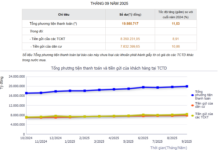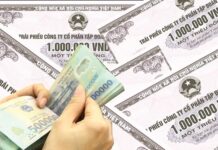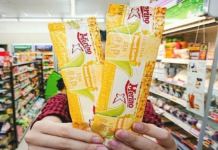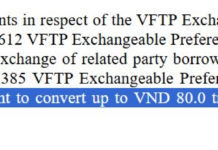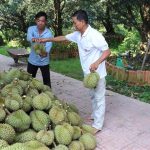Three premium fruits—peony grapes, red grapes, and milk pears—are seeing a drop in prices, according to Ms. Nguyen Thi Tuyet Nga, owner of a high-end fruit import store in Ho Chi Minh City. This is due to China’s successful domestic cultivation and increased exports of these fruits, breaking the previous monopoly held by South Korean and Japanese producers.
Peony Grapes at Bargain Prices
Previously, peony grapes imported from South Korea and Japan could cost up to several million dong per kilogram. Now, supermarkets and stores like Bach Hoa Xanh offer Chinese-grown peony grapes at a much more affordable price of VND 69,000 per 500-gram box. Buying two boxes further reduces the price to VND 49,000 (equivalent to VND 98,000 per kg). Co.opMart also sells these grapes, but at a slightly higher price of VND 95,900 per kg.
At traditional markets, there are times when peony grapes can be found for as low as VND 50,000-80,000 per kg, although the freshness may not match that of supermarket stocks. “In terms of taste and appearance, Chinese peony grapes rate 6-7/10 compared to their South Korean counterparts, lacking the same crispness, sweetness, and juiciness. However, the price is more accessible to the majority of consumers,” Ms. Nga commented.
Australian-variety red grapes grown in China offer similar quality to their Australian counterparts but at half the price, costing over VND 100,000 per kg. Similarly, a box of 15 kg of Chinese milk pears costs only VND 600,000 (equivalent to VND 40,000 per kg), while a box of 5 kg of South Korean brown pears can reach VND 650,000 (VND 130,000 per kg).
Due to the influx of Chinese produce, South Korean peony grapes have seen a price reduction but still remain 3-4 times more expensive than their Chinese counterparts.
Ms. Nga added that Chinese fruits come in various types and prices, and reputable vendors will source their products from companies that import through official channels, ensuring export-quality standards for demanding markets. Consumers are advised to be cautious and avoid buying substandard or mislabeled produce.
It’s not just milk pears and peony grapes that have become more affordable. Many other imported fruits that were once scarce and expensive are now a third or even half the price they were a few years ago. Supermarket chains like MM Mega Market, Big C, and GO! have frequently offered “super discounts” on imported apples, oranges, and more from the US, France, and China since the beginning of the year. Even now, these supermarkets are running promotions on South African apples, selling them at just VND 39,000 per kg.
Some savvy shoppers have taken advantage of end-of-day discounts at Bach Hoa Xanh, scoring incredible deals like Koru apples from New Zealand for just VND 15,000 per kg (originally nearly VND 63,000 per kg).
Fruits that were once considered luxury items for the wealthy, such as Envy apples, cherries, and kiwis, have now become more accessible to the general public, with a range of price points to choose from. “The reduction in import taxes on goods, including fruits, from various markets into Vietnam has played a role in making imported produce more affordable,” explained the marketing director of a major supermarket chain in Ho Chi Minh City. “However, the main reason is the increasing number of companies engaging in the import and distribution of fruits from different countries. Additionally, retail companies themselves are taking the initiative to import and sell these fruits at lower prices to attract more customers.”
According to industry insiders, the key to importing foreign fruits into Vietnam lies in large-volume imports and quick turnover. When companies import in bulk and sell quickly, they can negotiate better prices from overseas suppliers, further driving down costs and retail prices.

Chinese grapes on sale at Hoc Mon wholesale market. Photo: NGOC ANH
Caution with Near-Expiry Products
It’s not just fruits that have become more affordable; imported seafood products like salmon and scallops, once considered luxury items, have also become more accessible. Salmon, for example, comes in various types and origins, including Norway, Canada, Japan, and even locally farmed salmon. However, while salmon prices have dropped, there is a notable price discrepancy between different sales channels. Specialty stores for imported gourmet foods maintain their own price segments, supermarkets have their own pricing, and e-commerce platforms often display a wide range of prices.
“The fundamental principle is to buy products that match the quality you’re paying for,” advised a representative from an importing company.
Mr. Tran Van Truong, General Director of Hai San Hoang Gia International Trading Company, noted that for imported seafood, seasonal fluctuations play a significant role in pricing. Typically, purchasing during the peak harvesting season can result in savings of 20%-30% compared to other times of the year. “In developed countries, they carefully manage harvesting to avoid drastic price drops. Occasionally, there may be batches of seafood at extremely low prices due to approaching expiration dates or export defects, but these cases are not common. Consumers should be cautious of unusually low prices,” Mr. Truong warned.
At a recent event on the F&B industry, expert Do Duy Thanh shared an example of a steakhouse chain that imported three tons of foreign beef at just VND 180,000 per kg, significantly lower than the usual price of VND 280,000 per kg, because the meat had less than six months until its expiration date. “If you can ensure the product will be consumed before its expiration, this can be a cost-saving opportunity. However, careful calculations are necessary to avoid the risk of long-term storage,” Mr. Thanh advised.
Japanese Scallops at a Discount
According to the Vietnam Association of Seafood Exporters and Producers (VASEP), citing data from Japan’s Ministry of Finance, in the first half of 2024, Japan’s exports of frozen scallops in shells to Vietnam reached 13,075 tons, a nearly 21-fold increase compared to the same period last year. The average price was 231 JPY/kg (approximately VND 40,000 per kg), a decrease of nearly 50% compared to the previous year.
A survey of several e-commerce platforms revealed that many vendors are offering discounts on this product. For instance, Japanese scallops are priced at VND 115,000 per kg (a 36% reduction), and a single-piece Japanese scallop costs VND 158,000 per kg (a 20% discount).
Sure, I can help you with that!
Here’s a revised version of the text:
“The Master of Finance Turned Entrepreneur: How the ‘Leftover’ 10 Tons of Pomelos Propelled the Founder of Klever Fruit to Success with 55 Retail Stores of Imported Fruits”
With nearly two decades of entrepreneurial experience and a thriving imported fruit chain boasting 55 stores across Hanoi and Ho Chi Minh City, one would expect a deluge of results when Googling the name “Nguyen Xuan Hai” – the founder and CEO of Klever Fruit. However, the opposite is true, and the scarcity of results is surprising.





